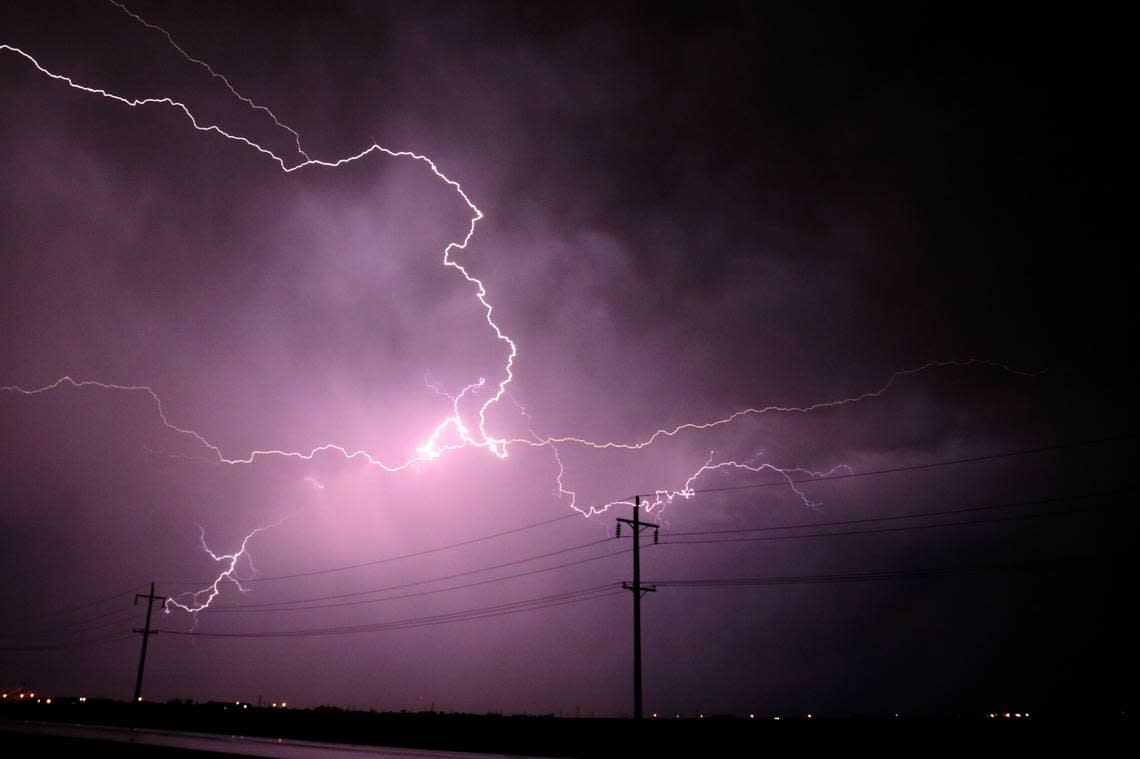UPDATE: Nickel-sized hail expected with thunderstorms in Wise County Monday

An updated weather alert issued by the National Weather Service on Monday at 9:37 p.m. is warning residents of strong thunderstorms until 10 p.m.
Wind gusts of up to 40 mph and nickel-sized hail (0.88 inches) are expected.
"At 9:37 p.m., Doppler radar tracked a strong thunderstorm 7 miles south of Lake Bridgeport, or 8 miles southwest of Bridgeport, moving northeast at 25 mph," states the NWS. "Gusty winds could knock down tree limbs and blow around unsecured objects. Minor damage to outdoor objects is possible."
Expect strong thunderstorms in the following locations:
• Bridgeport and Lake Bridgeport around 9:40 p.m.
• Paradise around 9:50 p.m.
Other locations impacted by this storm include Balsora, Boonsville, Runaway Bay, Lake Bridgeport, and Cottondale.
The NWS comments, "If outdoors, consider seeking shelter inside a building. A Severe Thunderstorm Watch remains in effect until 10 p.m. for north central Texas."
This alert is in effect until 10 p.m.
Actions to take when lightning threat is imminent
Lightning strikes the United States about 25 million times a year. Most of the strikes occur in the summer, killing 20 people each year, according to the NWS. Chance of lightning increases as a thunderstorm approaches and peaks when the storm is overhead. It diminishes as the storm moves away.
Here are tips on how to stay safe during a thunderstorm:
• To minimize risk of being struck by lightning, when going outside, have a plan to get to a safer place.
• If the sky becomes threatening and thunder can be heard, find a safe place to shelter.
• Once inside, avoid contact with corded phones, electrical equipment, plumbing, and windows and doors.
• Wait 30 minutes after the last lightning or thunder before going back outside.
If finding indoor shelter is not an option:
• Avoid open fields, hill peaks, or ridge tops.
• Avoid tall, isolated trees or other elevated objects. If you are in a forest, stick to areas with shorter tree cover.
• If you are in a group, spread out to avoid the current traveling between group members.
• If you are camping in an open area, set up camp in a valley, ravine, or other low area. Remember, a tent offers no protection from lighting.
• Stay away from water, wet items, and metal objects. Water and metal do not attract lightning but they are excellent conductors of electricity.
What steps to follow when driving in the rain?
• Switch on headlights — Even during daylight hours, using headlights can enhance visibility and signal your presence to other drivers.
• On the road — Drive in the middle lanes and stay on high ground. Rainwater tends to stockpile on the edges of roads.
• Keep clear of puddles — Driving through puddles or low rainwater areas can cause vehicles to hydroplane or skid out of control
• Maintain a safe distance from large vehicles — Trucks or buses can produce a water spray that hampers visibility.
• Steer clear of flooded areas — When coming to a flooded road, turn around and head back. Flash flooding currents are strong and can sweep drivers off roadways. Driving through deep water can also affect a vehicle’s mechanical and electrical systems.
What is hydroplaning?
Hydroplaning is when a vehicle starts uncontrollably sliding on wet roads.
This happens when water in front of the tire builds up faster than the vehicle’s weight can push water out of the way. The water pressure then causes the vehicle to rise and slide on a thin layer of water between the tires and the road, making the driver lose control. The top three contributors to hydroplaning are:
1. Vehicle speed — When a vehicle’s speed increases, the tire-traction grip and ability to control the vehicle decreases. Drive at a reduced speed during wet weather.
2. Water depth — The deeper the water, the sooner a vehicle loses traction on the road. It doesn’t matter how deep the water is, even a thin layer can lead to hydroplaning.
3. Tire tread depth — Checking your tire tread before hitting the road is important, as low or no tread can lead to sliding.
In the event of your vehicle hydroplaning, here’s what to know:
• Ease off the accelerator — Step off the gas to slow down the vehicle until the tires find traction.
• Turn into the skid — Turning into the skid can help the vehicle’s tires realign to regain control.
• Make sure the tires reconnect with the road — During the skid, wait until the tires reconnect with the road and then gently straighten the wheels to regain control.
• Brake gently as needed — Brake normally if the vehicle has anti-lock brakes and pump brakes gently if in an older vehicle.
Source: The National Weather Service


